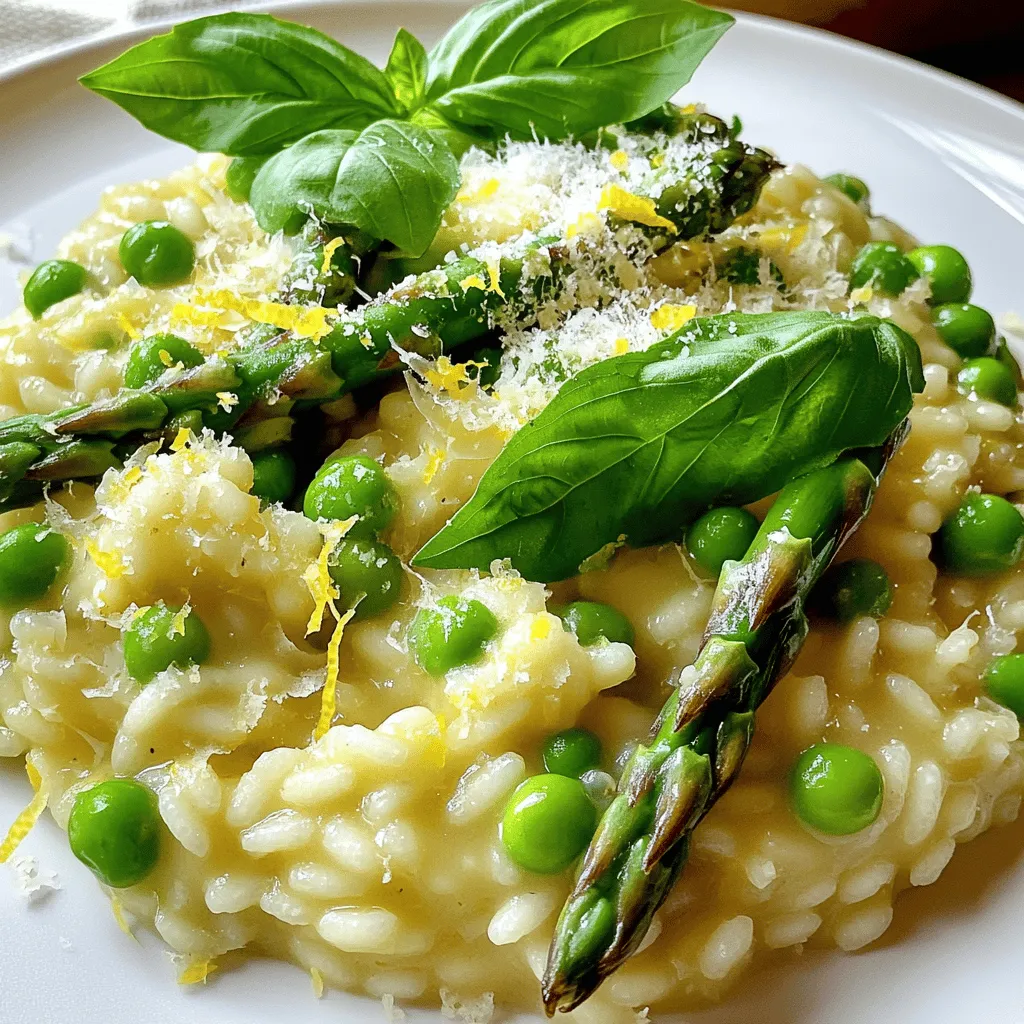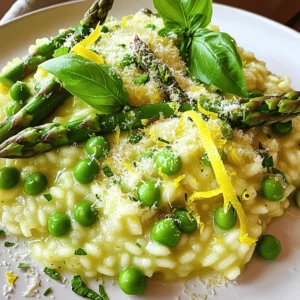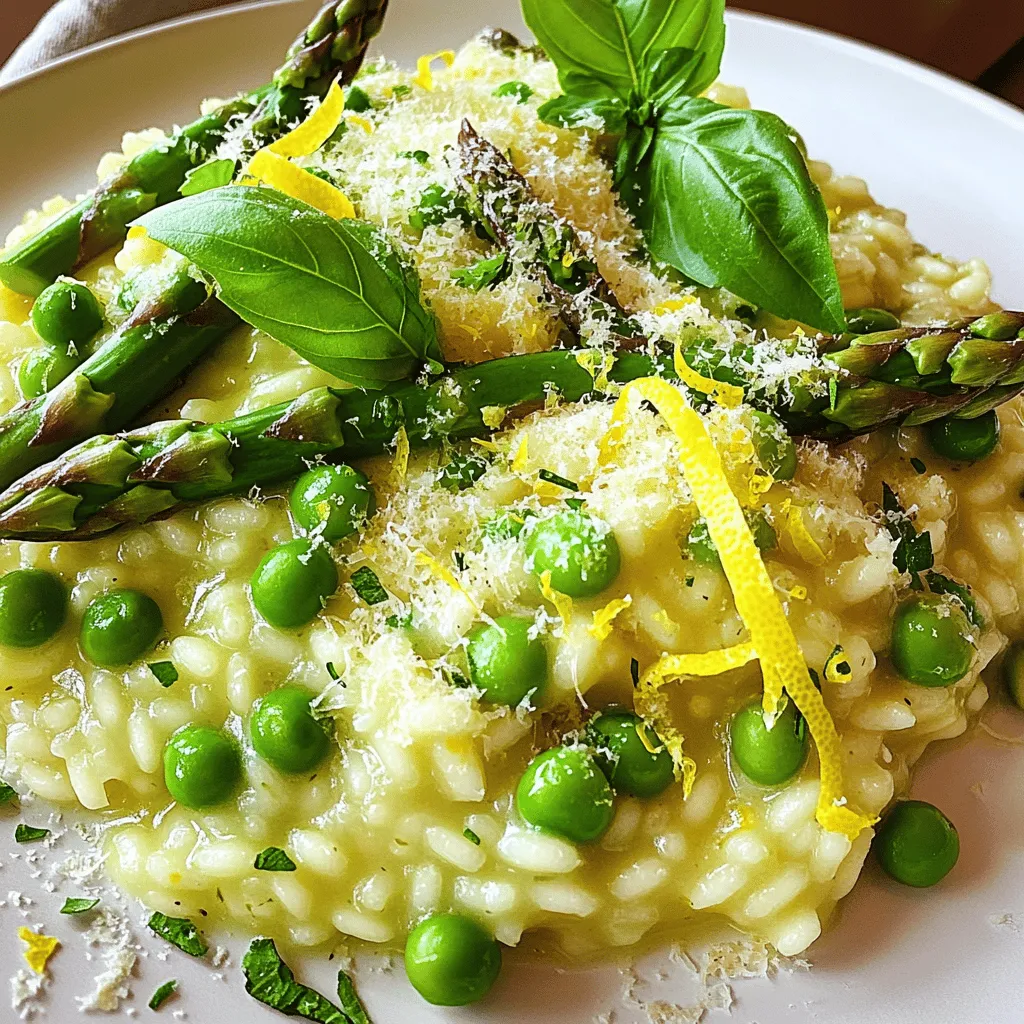If you’re looking for a vibrant, creamy dish, my flavorful asparagus pea risotto is perfect for you. This easy-to-make recipe bursts with fresh seasonal ingredients and will impress your family or guests. Whether you’re a vegetarian or just want a light meal, this dish ticks all the boxes. Join me as I guide you through the steps and tips to create a risotto that’s both delicious and healthy!
What Ingredients Do I Need for Asparagus Pea Risotto?
When making asparagus pea risotto, you need fresh, seasonal ingredients. The main star is Arborio rice. This rice has a high starch content, making the risotto creamy. You will also need vegetable broth. I prefer low-sodium broth to keep it light. Fresh peas add a nice pop of color and sweetness. You can also use frozen peas if fresh ones are not available.
Asparagus is another key ingredient. Trim it and cut it into 1-inch pieces. A small onion, finely chopped, adds flavor. Garlic, minced, gives a wonderful aroma to the dish.
For richness, use grated Parmesan cheese. It melts nicely into the risotto. Olive oil enhances the flavor and helps sauté the onion and garlic.
Lemon zest and lemon juice brighten up the dish. They add freshness and help balance the creaminess. Finally, season with salt and pepper to taste. Fresh basil leaves make for a lovely garnish.
What are the key ingredients for this risotto?
The key ingredients for this asparagus pea risotto recipe are Arborio rice, vegetable broth, asparagus, peas, onion, garlic, Parmesan cheese, olive oil, lemon zest, and lemon juice. Each ingredient plays a part in building flavor and texture.
Can I substitute ingredients in the recipe?
Yes, you can substitute some ingredients. If you do not have Arborio rice, you can use another short-grain rice, like Carnaroli. For a dairy-free option, skip the Parmesan cheese or use a vegan alternative. If you dislike asparagus, try spinach or zucchini instead.
How do fresh vegetables enhance the dish?
Fresh vegetables enhance the dish by adding vibrant flavors and textures. Asparagus offers a slight crunch, while peas add sweetness. Using fresh ingredients makes the risotto taste bright and lively. It also makes the dish more nutritious, providing vitamins and minerals. For the complete recipe, check out the Full Recipe section.
How Do I Make Asparagus Pea Risotto?
To make asparagus pea risotto, start with the right steps. You need Arborio rice, fresh peas, and asparagus. Gather your ingredients first.
What are the step-by-step instructions for cooking?
1. Heat 4 cups of vegetable broth in a medium saucepan over low heat.
2. In a large skillet, add 2 tablespoons of olive oil. Heat this over medium heat.
3. Chop 1 small onion and add it to the skillet. Sauté until it turns clear, about 3 to 4 minutes.
4. Add 3 cloves of minced garlic and cook for 1 more minute.
5. Put in 1 cup of Arborio rice. Toast it for 2 to 3 minutes, stirring often.
6. Now, add the warm broth one ladle at a time. Stir well and wait until most of the liquid is gone before adding more.
7. After about 15 minutes, add the asparagus pieces. Keep adding broth and stirring for 5 more minutes.
8. When the rice is tender, stir in 1 cup of fresh peas, lemon zest, lemon juice, and ½ cup of Parmesan cheese. Mix until creamy.
9. Season with salt and pepper. Adjust the lemon juice to your taste.
10. Remove from heat and let it sit for a minute before serving.
How do I ensure a creamy texture?
To get a creamy risotto, keep stirring as you add broth. This releases the starch from the rice, making it creamy. Use Arborio rice, as it has the right starch content. You can add a little extra broth if needed. The cheese also adds creaminess, so don’t skip it!
What cooking techniques are essential for risotto?
The key to good risotto is patience. Stirring helps the rice cook evenly. Always add broth slowly. This lets the rice absorb the liquid. Toasting the rice at the start gives it a nice flavor. Using warm broth keeps the cooking process steady. These techniques make your risotto rich and delicious.
For the complete dish, check the Full Recipe.

What Are Some Tips for Cooking Perfect Risotto?
Risotto is a dish that needs care. Here are some tips to help you.
What common mistakes should I avoid?
One big mistake is rushing the process. Stirring the rice slowly helps it absorb the broth. Another mistake is adding all the broth at once. This leaves the rice undercooked. Instead, add one ladle at a time. Wait until the rice absorbs it before adding more. This creates a creamy texture.
How can I enhance the flavors of my risotto?
To boost flavor, use fresh, high-quality ingredients. Fresh herbs like basil or parsley can add depth. Also, try using homemade broth for a richer taste. Lemon zest and juice brighten the dish. They add a fresh zing that pairs well with the asparagus and peas.
What are the best practices for using stock in risotto?
Using warm stock is key. Cold stock shocks the rice and ruins the texture. Keep the stock on low heat while cooking. This helps maintain the right temperature. Lastly, taste as you cook. Adjust the seasoning with salt and pepper. This ensures every bite is full of flavor.
For a full recipe, check out the Zesty Asparagus Pea Risotto above.
How Can I Customize My Asparagus Pea Risotto?
You can make asparagus pea risotto your own by adding fun ingredients. One way is to include different grains. Try farro or quinoa for a nutty twist. You can also swap Arborio rice for a whole grain option.
Adding herbs and spices can change the flavor. Fresh basil adds a sweet note. If you want more heat, try some crushed red pepper. For a hint of earthiness, use thyme or rosemary. Just remember to add these toward the end of cooking to keep their fresh taste.
Many add-ins work well with asparagus and peas. You might add mushrooms for a savory touch. Sun-dried tomatoes can bring a burst of flavor. For protein, consider chickpeas or white beans. They make the dish heartier and more filling.
If you want a creamy vegan option, use cashew cream instead of cheese. Nutritional yeast can give a cheesy flavor while staying plant-based. For a zesty kick, a splash of balsamic glaze can elevate your dish nicely.
These variations provide a delightful twist. Feel free to experiment and find your favorite mix. You can find the full recipe to get started on your custom risotto adventure.

What Are the Nutritional Benefits of Asparagus and Peas?
Asparagus and peas pack a punch of nutrients. Asparagus is low in calories but high in fiber, vitamins, and minerals. One cup of asparagus gives you vitamins A, C, E, and K. It also has folate, which is great for cell health.
Peas are tiny powerhouses too. They are rich in protein and fiber. They also offer vitamins A, C, and K, plus many B vitamins. Peas help keep your heart and bones healthy.
How do asparagus and peas contribute to a healthy diet?
Both asparagus and peas fit well in a healthy diet. They help control weight due to their low calorie count. Their high fiber content aids digestion. Eating these foods can lower the risk of heart disease. They also support healthy skin and good vision.
What vitamins and minerals can I expect from this dish?
This risotto is a great source of key nutrients. Each serving contains vitamins A, C, K, and several B vitamins. Asparagus provides antioxidants, which protect your cells. Peas add protein and fiber, making the dish filling. Plus, the olive oil adds healthy fats.
Are there any dietary considerations for this recipe?
Yes, there are some things to keep in mind. This dish is vegetarian, making it great for many diets. If you are lactose intolerant, you can skip the Parmesan cheese or use a dairy-free option. For gluten-free eaters, this dish is naturally gluten-free since it uses Arborio rice. Always check for any allergies to specific ingredients too.
This recipe is not just tasty; it’s also a smart choice for your health. For the full recipe, check the complete instructions above.
How Can I Make Asparagus Pea Risotto Ahead of Time?
You can make asparagus pea risotto ahead of time, and it’s simple. First, cook the risotto as directed in the Full Recipe. Let it cool completely before storing.
What storage methods work best for leftover risotto?
Store leftover risotto in an airtight container. Keep it in the fridge for up to three days. If you want to keep it longer, freeze it. Use a freezer-safe container or bag. Remember to label the container with the date. This helps you track how long it has been stored.
How can I reheat risotto while retaining its texture?
To reheat risotto, add a splash of broth or water. This keeps it creamy. Heat it slowly on the stove over low heat. Stir it often to avoid sticking. You can also use the microwave. Just cover the dish and heat in short intervals, stirring in between.
What meal planning strategies can I use with this recipe?
Plan to make a large batch of risotto. You can enjoy it for lunch or dinner. Pair it with a side salad or some grilled chicken for a full meal. You can also add different toppings each day. Try nuts, fresh herbs, or different cheeses to change it up. This keeps your meals exciting and fresh!
Asparagus pea risotto offers fresh flavors and easy customization. Key ingredients include seasonal veggies that enhance taste. You learned how to make creamy risotto with clear steps and essential techniques. Avoid common mistakes to elevate your dish’s flavor. Nutritional benefits from asparagus and peas boost your health. Whether making it ahead or exploring variations, this risotto is a versatile choice. Enjoy every bite and experiment with different add-ins to make your dish unique. Transform your meals with this delicious recipe.







